Steve Urszenyi's Blog
November 18, 2025
BLOOD OATH Launches Today!
November 18, 2025
Today is a day I’ve been working toward for years. As I write this, I’m thinking about all the miles traveled—literal and literary—to bring this story to life. Publishing a new thriller feels like one adventure racing into the next, with a lot of heart and a dash of adrenaline.
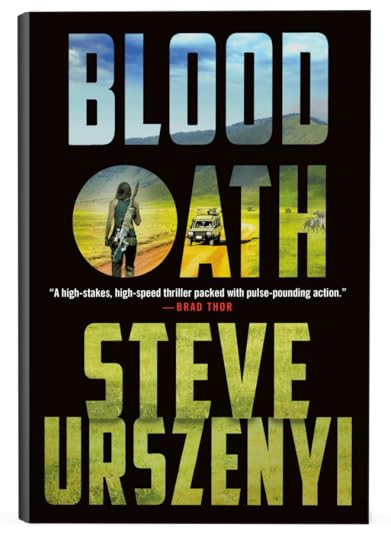 Today, Blood Oath Is Yours
Today, Blood Oath Is YoursBlood Oath is officially out in the world! And before anything else, I want to thank you for your incredible support. If you preordered, shared a post, recommended Alex Martel to a fellow thriller fan, or just hit “open” on these newsletters, you’ve had a direct hand in breathing life into this book. While I may have done the typing, you are the reason Alexandra Martel’s story continues.
Every preorder, every bit of advance buzz, helps publishers, booksellers, and readers take notice. It’s a gift I don’t take for granted, and it truly means more than I can say.
The Team That Made It PossibleA book is always a team effort, and I am lucky to work with some of the best in the business at Minotaur Books/St. Martin’s Press:
Michael Homler, my editor at Minotaur, whose insight and patience—especially patience—turned Blood Oath into a sharper, deeper, more thrilling ride than I ever thought possible.
Maddie Alsup, editorial assistant extraordinaire, who keeps the process humming behind the scenes.
Stephen Erickson, my bridge to readers everywhere—and the architect of so many wild and creative marketing campaigns.
Hector DeJean, publicist and champion of the book, who brought the story to dozens of new reviewers and readers.
Kelley Ragland and Keith Kahla, whose steady hands and wisdom make Minotaur such a supportive creative home.
And a profound thanks to my agent, John Talbot, for his unwavering belief in me, his wise counsel, and his ability to open doors and keep me focused on what matters most: telling stories that matter.
I am deeply grateful to each of you.
Why This One MattersBlood Oath is, for me, the most personal story I’ve ever written. It’s about bonds that can’t be broken, honor tested on impossible terrain, and what happens when you’re forced to choose not just between right and wrong, but between competing rights. It’s a thriller with a pulse, but also, I hope, a heart.
I poured everything I had into this book—the landscapes of Tanzania, the pulse of real-world experience, and everything I’ve learned across a lifetime as a paramedic and now as a storyteller.
I hope it grips you, moves you, and has you rooting for Alex from first page to last.
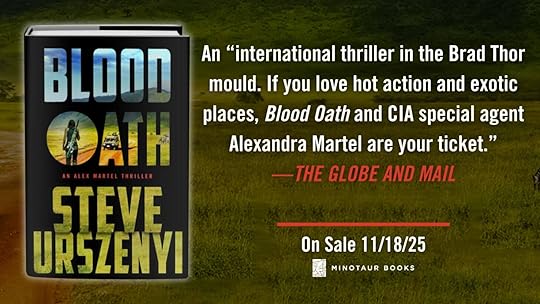 Looking Ahead
Looking AheadI’m excited to share that I’ll be appearing at The Poisoned Pen in Scottsdale, AZ, in December to talk about Blood Oath. We had to change the original date due to circumstances beyond my control. More details on that and other upcoming events will be coming your way soon.
In the meantime, I’m not slowing down. I’m already hard at work on new projects—both inside the Alex Martel universe and farther afield. Some are thrillers, some tug at different genres. But no matter where the next story takes me, I’ll be bringing the same passion, research, and love of suspense that you’ve come to expect.
I hope you’ll keep reading, keep sharing, and keep following along as this journey continues. Your enthusiasm for Alex and her world means everything—and I can’t wait to introduce you to whatever comes next.
With Sincere ThanksThank you for walking this path with me. For reading, for supporting, for believing.
If you enjoy Blood Oath, I’d be grateful if you’d share your thoughts in a review—on Amazon, Goodreads, social media, or wherever you hang out online. Your words help new readers find Alex and Friends and let me keep writing the stories I love.
With every page, every adventure, and every heartfelt thank you,
Steve Urszenyi
P.S. More exciting news about events and appearances coming soon—stay tuned!
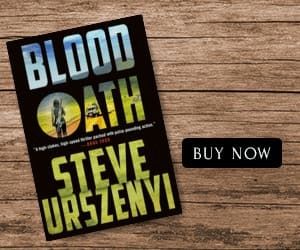
Blood Oath releases TODAY, November 18, 2025! Order your copy and discover how ancient honor codes drive the most modern of thrillers.
🇺🇸 Amazon US: Order on Amazon US
🇨🇦 Amazon Canada: Order on Amazon Canada
📖 Indigo Books: Order on Indigo Books
🏢 Barnes & Noble: Order on Barnes & Noble
📚 Novel Spot (Local Indie): Order from Novel Spot
#BloodOath #OrderNow #ThrillerBooks #AlexMartel
November 13, 2025
Into the Heart of Africa: Part 8
The words came to me on that last morning in the Serengeti, watching dawn break over the endless plains. Not consciously—more like they’d always been there, waiting for the right story to claim them. Five days from now, when Blood Oath releases, readers will discover how that childhood promise between Alex and her father became the emotional foundation for the entire novel.
But the journey from safari to story wasn’t straightforward. It never is.
The Moment It ClickedI can pinpoint the exact instant Blood Oath was born. We were surrounded by elephants in Tarangire—massive bulls and protective mothers with calves, walking so close to our Land Cruiser that it actually moved. We sat motionless, barely breathing, completely at the mercy of creatures that could crush us without even noticing.
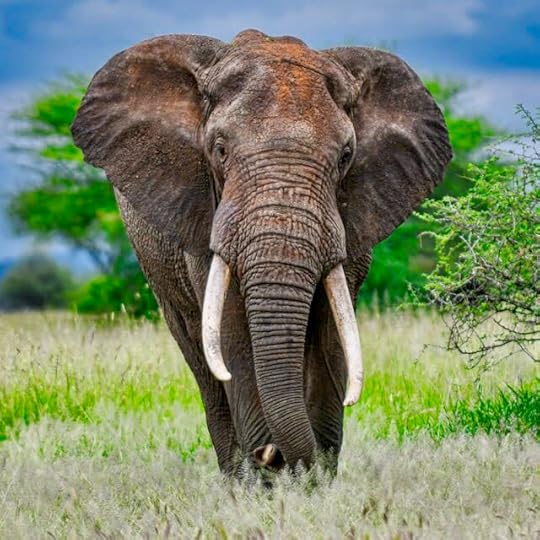

In that moment, I experienced something profound: the simultaneous rush of awe and the stark recognition of our own vulnerability. That feeling—that perfect balance between wonder and terror—became the emotional core of Blood Oath.
When I started writing, I knew Alex’s story needed to capture that same dynamic. She’s one of the world’s most capable operators, yet in Tanzania, she’s powerless. Her father has been taken by rebels. She’s surrounded by beauty that could kill her. She possesses extraordinary skills that mean nothing if she can’t reach him in time.
Real Experiences, Fictional StakesThroughout this series, I’ve shared the real moments from our Tanzania safari:
A passenger’s vasovagal episode on the flight to Amsterdam that reminded me how medical emergencies happen anywhere
The monkey stealing breakfast at the Arusha Serena that introduced us to Africa’s unpredictability
The elephants in Tarangire teaching us about vulnerability and power
The lions in Ngorongoro demonstrating tactical hunting coordination
Sanka and the Maasai showing us that honor codes transcend culture
The endless plains of the Serengeti proving that vastness changes perspective
The leopards on the kopjes revealing how elevation equals survival
Each of these experiences found its way into Blood Oath, transformed by fiction’s alchemy into something both true and invented.
Characters Born from Real PeopleJames Urio, our guide, transformed into James in the novel: knowledgeable, warm, proud of his country. In the book, he’s driving Alex and General Martel when violence erupts. His character represents all the Tanzanians we met who navigate the complex intersection of tradition and modernity, conservation and survival.
Sanka, the chief’s son at the Maasai village, inspired the character of Lemarti—though in reverse. While Sanka embodied dignity and wisdom, Lemarti represents what happens when honor codes become twisted by desperation and exploitation. The talking stick Sanka gave us—that symbol of sacred family responsibility—became the blood oath between Alex and her father.
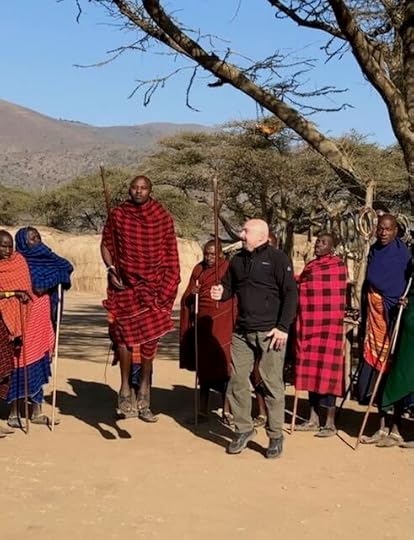
General David Martel is pure fiction, but his relationship with Alex draws from something deeply personal. My daughter lives in London now—an ocean away from Toronto—and I understand completely the paradox of raising someone strong enough to leave while never quite letting go of the promise to always be there if she needs me. When General Martel promises eleven-year-old Alex he’ll always come look for her if she’s lost, he’s making the same promise I’ve made, the same promise countless parents make, knowing our children will go farther than we can follow. The difference is that in the Martels’ world, that promise becomes an operational reality rather than a helpless wish spoken across time zones.
The Writer’s ResponsibilityAfter 30 years as a paramedic and police tactical medic, I’ve responded to terrorist bombings, elevator accidents, building collapses, mass-casualty incidents, and situations where split-second decisions meant life or death. Those experiences taught me what Alex knows instinctively: training takes over when chaos erupts, muscle memory supersedes conscious thought, and sometimes you do the right thing simply because someone needs help, despite the personal risks.
That’s why Blood Oath needed to feel authentic—not just in tactical details, but in emotional truth. When Alex treats the wounded ranger using improvised materials, she’s drawing on the same principles I employed thousands of times. When she makes impossible choices under pressure, she’s operating from the same place every first responder knows: you do what needs doing, then process it later.
The Themes That EmergedAs I wrote Blood Oath, certain themes kept surfacing—themes I hadn’t consciously planned but that emerged from the Tanzania experience:
Sacrifice: What are you willing to give up to protect those you love? For the Maasai, it’s navigating between tradition and survival. For wildlife rangers, it’s risking their lives against poachers. For Alex, it’s everything.
Honor: What codes govern your behavior when law and civilization are absent? Sanka taught us that honor isn’t abstract—it’s choosing the harder right over the easier wrong, every single day.
Connection: What bonds transcend culture, geography, and circumstance? The parent-child relationship, the trust between guide and guest, the shared humanity that emerges when we witness something magnificent together.
Vulnerability: How do you maintain strength while acknowledging fragility? Those elephants taught us that power and vulnerability coexist. Alex learns the same lesson when her father is taken—being capable doesn’t mean being invincible.
The Medical FoundationAlex’s background as a combat medic comes directly from my paramedic experience. When she fashions a tourniquet from a triangular bandage and trauma shears, she’s using techniques I’ve used and taught for decades. When she assesses injuries with practiced efficiency, she’s operating from the same training that becomes instinct after years in the field.
But Blood Oath isn’t a medical thriller—it’s a story about what happens when a healer must become a warrior. Alex’s medical skills save lives throughout the novel, but they also create impossible choices. Do you stop to treat the wounded when doing so might cost your father his life? How do you balance the Hippocratic Oath with the blood oath you swore as a child?
These aren’t abstract questions for first responders, military personnel, or anyone who’s sworn to protect others. They’re daily realities, and Tanzania showed me how to explore them through fiction.
The Technical DetailsI’m often asked how I make the action sequences feel authentic. The answer is research, experience, and respect for the craft.
The weapons Alex uses, the tactics her team employs, the communications protocols they follow—all drawn from extensive research and consultation with experts as well as personal experience. The kopjes that provide tactical advantage in the novel are the same granite outcrops where we watched that mother leopard call to her cubs. The distances, sight lines, and environmental challenges come from our actual safari.
But I also know when to prioritize story over strict accuracy. Blood Oath isn’t a training manual—it’s a thriller that needs to maintain tension while respecting the reader’s intelligence. The balance is delicate: detailed enough to feel authentic, streamlined enough to maintain pace. If I got any of it wrong, that’s on me.
What Tanzania Taught Me About WritingOur safari taught me lessons that transcended the immediate experience:
Patience produces better results: Just as waiting for the perfect photo meant missing a dozen good ones, waiting for the right scene, the right word, the right emotional beat produces stronger fiction.
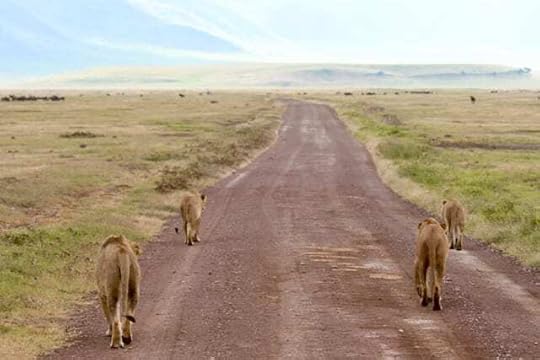
Perspective matters: From ground level, the Serengeti seems infinite. From the air, patterns emerge. Both perspectives are true, and good writing requires both—the intimate and the expansive.
Beauty and danger coexist: The most stunning moments often carry inherent risk. The best fiction embraces that tension rather than resolving it prematurely.
Connection is universal: Whether it’s Sanka sharing his culture, James teaching us about wildlife, or that monkey stealing breakfast, authentic human (and animal) interaction transcends barriers. Characters that feel real forge connections that last beyond the final page.
The Blood Oath ItselfThe central conceit of the novel—that Alex and her father swore a blood oath when she was a child—came from the Maasai talking stick and my own memories of childhood promises. As kids, we make grand declarations: “I’ll always protect you,” “I’ll never leave you,” “I’ll come find you no matter what.”
Most of us outgrow those promises, recognizing them as the beautiful impossibilities they are. But Alex Martel doesn’t have that luxury. She’s built a life around making the impossible possible. When her father is taken, that childhood oath becomes her operational directive.
The physical scar on her palm—matching her father’s—is a constant reminder that some promises transcend childhood. In the novel’s most intense moments, she touches that scar, drawing strength from the bond it represents.
Five Days AwayBlood Oath releases in five days. By the time you read this, review copies are circulating, early readers are sharing reactions, and the machinery of publication is humming toward that November 18th date with destiny.
I’m both excited and terrified, which seems appropriate for a story born from that morning surrounded by elephants—awed and vulnerable in equal measure.
What I hope readers take from Blood Oath isn’t just a thrilling story, though I’ve worked hard to deliver that. I hope they feel the same connection to Africa that I felt, the same respect for the people navigating impossible choices, the same understanding that heroism isn’t about being fearless—it’s about acting despite fear because someone needs help.
Thank You for This JourneyFor eight weeks, you’ve walked beside me through Tanzania. You’ve witnessed elephants touching our jeep, lions hunting zebra, leopards calling to their cubs, and Maasai warriors sharing their culture. You’ve experienced the endless plains where humanity first stood upright and looked toward the horizon.
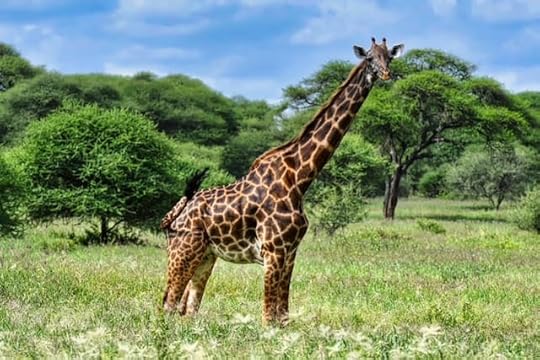
You’ve also witnessed how real experiences become fictional truths—how a safari becomes a thriller, how wonder becomes narrative, how the lessons learned in Tanzania’s wildlife theater become principles that drive a character’s most crucial decisions.
Blood Oath exists because of that June 2019 safari. But it also exists because of three decades as a paramedic, years as a tactical medic, and a lifetime of understanding that the truest adventures aren’t fantasies—they’re reflections of the world as it actually exists: beautiful and dangerous and complex and utterly worth fighting for.
Asante sana to everyone who’s followed this series. To Lynne, Tina, and Joan, who shared the safari. To James Urio, who guided us with wisdom and joy. To Sanka, who opened my eyes to what honor truly means. To every Tanzanian who welcomed us and shared their magnificent country with us.
And to you, dear readers, who’ve trusted me to take you on this journey from safari to story, from experience to fiction, from Tanzania to Blood Oath.
The adventure concludes where it began: with a promise.
Blood of my blood, until my last breath.
See you in the Serengeti.
Steve Urszenyi

Blood Oath releases November 18, 2025—just 5 days away! Preorder your copy today and discover how the greatest show on Earth inspired Alexandra Martel’s most dangerous mission.
🇺🇸 Amazon US: Order on Amazon US
🇨🇦 Amazon Canada: Order on Amazon Canada
📖 Indigo Books: Order on Indigo Books
🏢 Barnes & Noble: Order on Barnes & Noble
📚 Novel Spot (Local Indie): Order at Novel Spot
November 6, 2025
Into the Heart of Africa: Part 7
On our final morning in the Serengeti—Thursday, June 13th—I woke knowing the safari was almost over. What had begun as a simple wildlife expedition had become something I hadn’t anticipated: a journey not just across Tanzania’s magnificent landscapes, but through questions about connection, culture, and what stories are worth telling.
“Got to sleep in and didn’t leave the lodge until 9 AM,” I wrote that morning. For the first time all week, we weren’t chasing sunrise or racing against the mandatory 6 PM curfew. We had time to simply be—to absorb everything we’d experienced, to feel the weight and wonder of it all.
 Saying Goodbye to James
Saying Goodbye to JamesJames drove us to the Seronera Airstrip for 10 AM, and the farewell hit harder than any of us anticipated. “Said goodbye to him—sad,” I noted matter-of-factly in my journal, the word barely capturing the emotion of that moment.
“He was the most amazing guide and driver we could ever have had,” I wrote. “So kind and friendly and always had a smile on his face.”
But James had been more than a guide. Over those nine days, he’d become a teacher, a translator, a bridge between our world and his. His encyclopedic knowledge of Tanzania’s flora and fauna amazed us daily. More importantly, his love for his country—its wildlife, its people, its complexity—infected us with the same passion.
Looking back, I didn’t realize at the time just how much Seronera would linger with me. It would be nearly five years later, sitting at my desk and crafting Blood Oath, that I’d return to that small airstrip in my imagination. The very same Seronera airport where we said goodbye to James became the exact place General David Martel was headed in the novel when his world changed forever. In life, it was just another farewell at the end of a journey—but in fiction, it became a turning point.
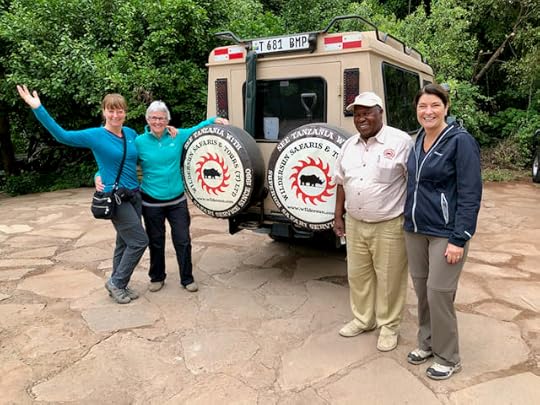
When I created the character of James in Blood Oath—the guide who drives Alex and General Martel through the Serengeti—I drew directly from our experience with our own guide. In the novel, when Alex and her father banter with their guide, when James educates them about animal behavior, when he navigates both the physical landscape and the cultural terrain with equal skill, those moments were informed by our real experience.
The bond between guide and guest in Africa runs deeper than the typical tourist relationship. James entrusted us with his knowledge, his stories, his country. In return, we gave him our trust when elephants jostled our vehicle, when lions stalked within feet of us, when he assured us the fog would lift once we descended into Ngorongoro Crater.
That trust became central to Blood Oath. When violence erupts and Alex faces impossible choices, her relationship with James serves as an anchor—a reminder that even in chaos, human connection persists. She also discovers that after trusting James to keep her safe as he guides them through the wilderness, it is now Alex who must protect him.
Flying Over the LandscapeAt the Seronera Airstrip, we boarded a Twin Otter—about 20 passengers—and took off from a dirt runway. “It was like being on a hop-on, hop-off bus,” I noted. “The captain kept hopping out to let people off and get their bags, and then she would climb back in and off we went again.”
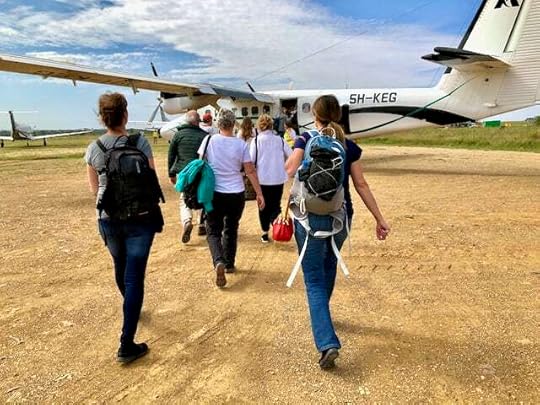
Our pilot hopped in and out of the cockpit between airstrips with the casual competence of someone who’d done this a thousand times. Watching her navigate the plane over the Serengeti with such effortless authority, I saw Alexandra Martel more clearly—not as an idea on the page, but as someone real.
From the air, we could see the circles of Maasai villages scattered throughout the plains. We flew over the arts and cultural center we’d visited days before—“really big complex from the air.” The perspective shift was profound: what seemed vast and overwhelming from ground level became ordered and comprehensible from above.
The Arusha Coffee LodgeIn Arusha, our new driver, Peter, took us to the Arusha Coffee Lodge—“a beautiful place with large outdoor tables where we had a wonderful lunch and walked around the grounds, including the Shanga studios where people with disabilities learn various arts and sell their wares: jewelry, blown glass, cloth, paintings, etc.”

We stayed at the lodge for 4-5 hours, surrounded by coffee plants and the scent of roasting beans, watching artisans create beauty despite physical limitations that might have limited others. The Shanga studios embodied something I’d witnessed throughout Tanzania: resilience, adaptation, the refusal to be defined by circumstance.

In Blood Oath, when Alex encounters the child soldier Kijana, she sees that same resilience—a boy forced into violence but not defined by it, surviving through adaptation, clinging to humanity in circumstances designed to destroy it. Her decision to spare him, to give him a chance at redemption, reflects what I learned watching those artisans in Shanga: that disability, trauma, and circumstance don’t determine destiny. Choice does.
The Universal Language of FamilyThroughout our journey, I was struck by how universal certain human experiences are. Sanka and his Maasai family lived in circular huts covered with cow dung, following traditions unchanged for centuries. Yet when he spoke of his children’s education, his hopes for their future, his pride in his culture, I heard the same sentiments I felt about my children, the same that parents everywhere voice about theirs.
In the novel, General David Martel and Alex’s relationship embodies a sacred parent-child bond. The blood oath they swear when Alex is eleven—“Blood of my blood, until my last breath”—echoes the Maasai understanding that family ties transcend everything else. When Alex risks everything to save her father, she’s honoring not just their personal oath but a universal truth: we protect those we love, regardless of cost.
The Cost of ConnectionOur safari wasn’t without witnessing Tanzania’s complexities. Throughout our journey, James educated us about the ongoing challenges facing Tanzania’s national parks—the constant threat of poaching, the difficult balance between conservation and local communities’ needs for land and resources, the economic pressures that drive wildlife trafficking.
The rangers we saw patrolling the parks were fighting to protect wildlife from those who would exploit it for profit. The Maasai village we visited was navigating the impossible tension between preserving ancient traditions and surviving in a cash economy. James himself represented the bridge between worlds—educated, fluent in multiple languages, descended from the Chagga people, but working in Tanzania’s modern tourism economy.
These complexities became essential to Blood Oath’s authenticity. The novel doesn’t present Tanzania as either paradise or hellscape, but as a real place where real people navigate impossible choices. In the fictional story, I dramatized the very real threats that rangers face—the poaching incidents that make headlines, the violence that erupts over resources and territory. The ranger ambush in the novel is fiction, but it’s rooted in the actual dangers that Tanzania’s wildlife protectors confront.
Lemarti, the antagonist, isn’t a cartoon villain—he’s a product of his environment, shaped by colonial history, resource exploitation, and the power vacuums that international actors eagerly fill. When Alex faces him in the novel’s climax, she’s not just fighting evil. She’s confronting the consequences of centuries of extraction—of resources, of autonomy, of dignity. Her victory isn’t triumphant; it’s necessary and tragic in equal measure.
What Tanzania Taught MeBy the time we boarded our flight from Kilimanjaro—first to Amsterdam, then onward to Paris—I had filled my journal with observations, my camera with images, and my heart with something harder to quantify. Tanzania had changed us. Changed me.
I learned that vulnerability and strength often occupy the same space—that the tourists who climb into open vehicles surrounded by lions are both incredibly brave and profoundly foolish. That beauty and danger don’t exist in opposition but in conversation with each other. That ancient wisdom and modern reality must somehow find a way to coexist.
Most importantly, I learned about connection—between humans and nature, between cultures separated by oceans and united by fundamental truths, between the person I was when I arrived and the person I became through witnessing Tanzania’s magnificent complexity.
The Story That Had to Be WrittenFlying home, I knew I would write about this experience one day. But I didn’t want to write a travel memoir or a nature documentary in prose form. I wanted to capture what Tanzania had taught me about family, honor, sacrifice, and the bonds that define us.
Blood Oath became that story—Alex and her father’s safari interrupted by violence, their bond tested by impossible circumstances, their love for each other driving decisions that challenge everything they believe about justice and duty.
The novel asks questions Tanzania asked me: What would you sacrifice to protect those you love? How do you honor tradition while embracing change? When do the rules that govern civilization give way to the older, deeper rules written in blood and bone?
Coming Full CircleNext Thursday—in our final installment—I’ll share how these experiences crystallized into Blood Oath, how real moments became fictional scenes, how actual people inspired complex characters, and how a simple safari became the foundation for Alexandra Martel’s most personal mission.
But today, I want to acknowledge something that only became clear looking back: Tanzania didn’t just inspire a novel. It reminded me why I write thrillers in the first place.
We tell stories about heroes facing impossible odds because life itself often presents impossible challenges. We write about sacrifice and duty because those are not just abstract ideas, they’re everyday realities for paramedics on the scene of a shooting or car wreck on the highway, for police officers making split-second decisions in the field, for firefighters responding to an alarm, for military personnel deployed far from home, for rangers protecting wildlife in remote wilderness, for Maasai families navigating modern life, and for anyone who chooses the harder right over the easier wrong.
Tanzania showed me that the truest adventures aren’t fantasies. They’re reflections of the world as it actually exists—beautiful, dangerous, complex, and utterly worth fighting for.
That’s why I write thrillers. Not to escape reality, but to honor it.
Asante sana to James, to Sanka, to every Tanzanian who welcomed us and shared their world. You gave us more than memories. You gave us truth.
And truth, as any writer knows, is the only foundation strong enough to support fiction.
Steve Urszenyi

Blood Oath releases November 18, 2025—just 12 days away. Preorder your copy today and discover how the greatest show on Earth inspired Alexandra Martel’s most dangerous mission.
🇺🇸 Amazon US: Order on Amazon US
🇨🇦 Amazon Canada: Order on Amazon Canada
📖 Indigo Books: Order on Indigo Books
🏢 Barnes & Noble: Order on Barnes & Noble
📚 Novel Spot (Local Indie): Order at Novel Spot
October 31, 2025
One Launch Event, One Night—Let’s Talk BLOOD OATH
With Blood Oath releasing November 18th, I wanted to share what’s happening around launch and give you a heads-up on when we’ll gather to celebrate properly.
 The One Event You Don’t Want to Miss
The One Event You Don’t Want to MissOn Monday, November 17th, from 7:00–8:00 PM MST, I’ll be at The Poisoned Pen in Scottsdale, Arizona, for an in-person launch event! I’ll be in conversation with Ryan Pote, author of Blood and Treasure, talking about thrillers, Ryan’s debut novel, and everything that went into creating Alexandra Martel’s most personal mission yet.
If you’re anywhere near the Phoenix area, I’d love to see you there. It’s going to be a fantastic evening of books, conversation, and—knowing The Poisoned Pen—great energy from fellow thriller fans.
Event Details:Date: Monday, November 17th, 2025
Time: 7:00–8:00 PM MST
Location: The Poisoned Pen Bookstore, 4014 N Goldwater Blvd, Scottsdale, AZ 85251
More Info: The Poisoned Pen Event Page
Most of you won’t be able to attend in person, but fear not… this event will be broadcast live on their Facebook channel and posted for later viewing.
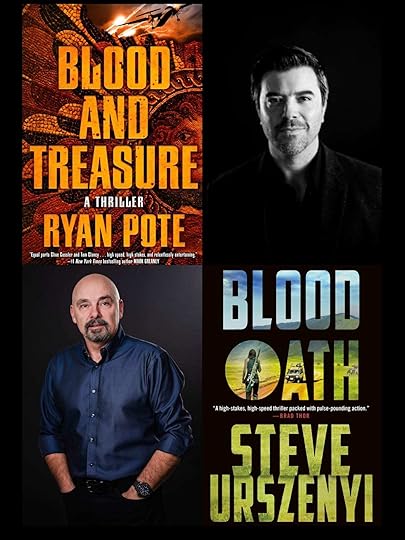 Why Just One Launch Event?
Why Just One Launch Event?Here’s the truth: November is a brutal time to launch a book. Between holiday travel, Thanksgiving prep, Christmas shopping, bookstore holiday chaos, and end-of-year mayhem, bookstores understandably prioritize their busiest retail season over hosting events, and suitable venues are locked up with corporate holiday parties and year-end celebrations.
I’m exploring the possibility of celebration events in the new year—when we can all catch our breath, settle in with good books, and really enjoy ourselves. But honestly? Nothing is carved in stone yet, and scheduling is always unpredictable. If something comes together, I’ll let you know.
But here’s the important part: please don’t wait for a maybe-event to get your copy.
Don’t Wait for a Launch Party to Get Your CopyIf you were planning to pick up Blood Oath at a launch event, here’s my ask:
Please don’t wait!
Preorder now (or grab a copy on release day, November 18th) from your favorite bookseller. Preorders and first-week sales make all the difference in how a book performs—they tell retailers, reviewers, and the publishing world that readers are excited about this story.
Plus, you’ll have Alex Martel’s latest adventure in hand right away, instead of waiting until next year when events roll around.
Where to OrderOrder from The Poisoned Pen directly and get a signed copy shipped to you: The Poisoned Pen Shop
Ask your local independent bookstore—they would love to order it for you!
Blood Oath releases November 18, 2025—just 18 days away. Preorder your copy today and discover how the greatest show on Earth inspired Alexandra Martel’s most dangerous mission.
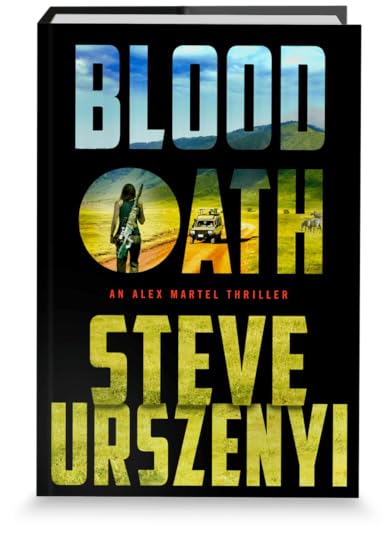
🇺🇸 Amazon US: Order on Amazon US
🇨🇦 Amazon Canada: Order on Amazon Canada
📖 Indigo Books: Order on Indigo Books
🏢 Barnes & Noble: Order on Barnes & Noble
📚 Novel Spot (Local Indie): Order at Novel Spot
If you’ve been following my Into the Heart of Africa newsletter series, you already know this one’s special. Blood Oath takes Alex Martel deep into Tanzania when her father, General David Martel, is kidnapped by a ruthless militia leader. It’s a story about family, honor, impossible choices, and what happens when the people we’d die for are the ones we have to save.
It’s my most personal thriller yet, and I can’t wait for you to experience it.
Stay ConnectedI’ll keep you posted as new year events come together. In the meantime, follow along on social media for behind-the-scenes updates, early reviews, and all things Alex Martel.
Thank you for your continued support. Whether you grab Blood Oath on release day, meet me in Scottsdale, or wait for one of next year’s events, I’m grateful you’re part of this journey.
See you soon—on the page, in person, or both.
Steve Urszenyi
P.S. If you can’t make it to Scottsdale but still want a signed copy, The Poisoned Pen ships anywhere in the U.S.! Just order through their website and request a signature in the order notes. In Canada, I hope to have a similar arrangement with a local bookstore soon.
Thanks for reading Medic Turned Scribe! Subscribe for free to receive new posts and support my work.
October 30, 2025
Into the Heart of Africa: Part 6
“Mission for the day is to see cats,” I wrote in my journal on Wednesday, June 12th. What followed would be the most spectacular morning of wildlife viewing I’ve ever experienced—and the inspiration for some of Blood Oath’s most intense sequences.
By noon, we had witnessed a mother leopard calling to her cubs, discovered an orphaned lion cub clinging to survival beside a wildebeest carcass, tracked a cheetah family through short grass, observed more than a dozen lions from the legendary Seronera Pride, and watched thousands of wildebeest erupt into their synchronized migration run. It was a masterclass in predation, survival, and the brutal elegance of the circle of life.
The Leopard’s DawnWe arrived at the Thach Kopje around 8 AM to find dozens of jeeps already positioned, their occupants scanning the grassland with binoculars. Then she appeared—the mother leopard we’d glimpsed the day before, emerging from tall grass and walking directly through the gathered vehicles with the casual confidence of absolute power.

James quickly maneuvered our Land Cruiser around the backside of the kopje, positioning us perfectly to see her climbing the ancient granite. Halfway up, she stopped on an exposed rock and began calling—a low, rumbling vocalization that carried across the silent savannah. She was summoning her cubs to their rendezvous among the cracks and caverns of the rock outcrop.
Watching her survey the endless plains from that elevated vantage point, I understood why leopards choose these kopjes. In a landscape of unrelenting flatness, height equals survival. From up there, she could see threats approaching from kilometers away, spot potential prey, and call her young to safety.
In Blood Oath, when Alex needs to observe Lemarti’s compound, she positions herself on a granite outcrop exactly like this one. The tactical advantage is the same whether you’re a leopard protecting your cubs or a CIA operative planning a rescue: elevation provides visibility, and visibility provides control.
While we waited for her cubs to appear, Lynne spotted a spotted eagle owl tucked into a bush among the rocks. “James was impressed again!” I noted. My wife had developed an uncanny ability to spot wildlife that even our expert guide sometimes missed.
The OrphanAround 9 AM, we came across a wildebeest carcass in grass beside the road. And there, barely visible in the shadows, lay a tiny lion cub—maybe three months old, alone and terrified.
We had driven past before realizing what we’d seen. When James reversed the Land Cruiser, the cub panicked and rolled himself back into taller grass. For several minutes, we caught glimpses of his head and ears before he lay down out of sight, conserving energy, waiting for a mother who might never return.

Just a few hundred yards down the road, we found a large male lion and female resting under a tree. James grew quiet, his usually animated narration replaced by a somber explanation. The presence of this new male so close to the abandoned cub told a brutal story: he had likely killed the pride’s previous male and was systematically eliminating cubs that carried another male’s genes. The cub we’d found might have been the only survivor.
“The male will kill off the cubs to force the female back into heat so that he can sire his own cubs,” James explained.
This harsh reality—infanticide as reproductive strategy—became thematically central to Blood Oath. In the novel, Alex witnesses a young boy soldier, Kijana, who has been orphaned and absorbed into Lemarti’s militia. Like that lion cub, he’s trying to survive in a world where the strong eliminate the weak, where family structures are shattered by violence, where adaptation means the difference between life and death. Alex’s mercy toward this child—her refusal to kill him even when it might save her father—echoes the complex moral landscape I first encountered watching that abandoned cub.
Speed Versus StealthAt 10 AM, James spotted something that made him brake suddenly: a cheetah with three cubs in the short grassland. Unlike lions, who hunt through coordinated ambush, or leopards, who rely on vertical terrain and stealth, cheetahs are pure velocity. They need open ground and clear sight lines to unleash the explosive speed that makes them Earth’s fastest land animal.
The mother was teaching her cubs these fundamentals. We watched as she demonstrated the patient observation that precedes the chase—that absolute stillness where every muscle is coiled, every sense focused, waiting for the perfect moment to explode into action.
I got some good pictures, but didn’t linger. We didn’t want to disturb this crucial learning process. In a few months, these cubs would need to hunt successfully on their own or starve. Their mother’s lessons meant the difference between life and death.
This became Alex’s operational philosophy in Blood Oath: sometimes you stalk like a leopard, using height and cover. Sometimes you hunt like a lion, coordinating with your team. And sometimes—when the moment demands it—you strike like a cheetah with explosive, overwhelming speed.
The Seronera Pride: A DynastyWhat happened next, between 11 AM and noon, demonstrated why the Serengeti is considered the best place on Earth to observe lion behavior.
We drove to an area where a small stream cut through the grassland. Immediately, we spotted two female lions walking along the river edge. They approached the road, then jumped across the stream in perfect synchronization—muscles rippling, utterly focused.
We followed them for a couple of hundred yards to a hippo pool where dozens of hippos wallowed with their young. Then James led us back in the direction we’d seen the two females, and suddenly there were six more lions—more females and some younger ones.

“This is all the Seronera Pride,” James announced with evident pride in his voice. He’d been tracking this dynasty for years.
We continued on and found another group of five lions resting under a tree. “Also part of the Seronera Pride,” James confirmed.
In less than two hours, we had observed what researchers call a “super pride”—a coalition of over a dozen related lions controlling vast territory through strength in numbers. These super prides hunt cooperatively for large prey like buffalo and eland, their coordinated tactics reminiscent of military operations.
Watching them, I understood what would drive the tactical sequences in Blood Oath. Caleb’s team—code-named RONIN—operates exactly like this Seronera Pride. Each member has a role. Moose with his heavy machine gun provides covering fire like the pride’s strongest hunters. Rook and his Delta teammates bring specialized combat skills. Alex herself functions as the pride’s scout and precision striker. When they assault Lemarti’s compound to rescue the general, they move with the same coordinated precision I witnessed that morning—trusting each other, communicating constantly, understanding that survival depends on the team.
The Greatest Show on EarthAround noon, just down the road from the last group of lions, we encountered something that stopped us cold: a massive herd of thousands of wildebeest that James said represented “the last part of the great migration.”
We watched them grazing beside us, the males grunting and posturing for their small territories. The collective sound—thousands of animals communicating, competing, living—created a low rumble that seemed to emanate from the earth itself.
Then, suddenly, one or two animals began to move.
What happened next was like watching a circuit complete. The entire herd—thousands upon thousands of wildebeest—erupted into motion, running in single file along the plain in perfect synchronization. The sound was thunderous. The sight was biblical. The dust cloud they raised obscured the horizon.

“It was unbelievable,” I wrote, my handwriting barely legible because my hand was shaking.
This was the Great Migration—up to 1.2 million wildebeest following ancient instincts and rainfall patterns in a never-ending cycle of survival. It’s been called “the greatest show on Earth,” and witnessing even a fragment of it left me speechless.
In Blood Oath, I captured this same sense of unstoppable momentum in the climactic action sequences. Once violence is unleashed, it takes on its own terrible logic and rhythm—like the migration, it becomes both inevitable and impossible to look away from. When Alex and her team engage Lemarti’s forces and Tarasenko’s Russian mercenaries in a three-way firefight, the action moves with the same inexorable force as those wildebeest—driven by primal imperatives, following patterns written into DNA or training, impossible to stop once begun.
The Leopard’s LarderAfter a picnic lunch, we came across a dead Thomson’s gazelle hanging from a branch in a tree—a leopard kill.
“The leopard would have fed as much as it wanted and then would leave the rest,” James explained. “But no other animal would eat it for fear of the leopard. It would just stay there for months.”
This grotesque monument to predator dominance—the gazelle’s body slowly mummifying in the African sun, untouched by scavengers out of sheer terror of the leopard’s return—became a powerful symbol in Blood Oath. Some kills serve as warnings. Some deaths echo long after the moment of violence passes. When Alex leaves bodies behind in her pursuit of her father’s kidnappers, she’s sending the same message that leopard sent: I was here. I am capable. Fear me.
The Mathematics of SurvivalThat morning taught me something crucial about both wildlife and thriller writing: survival isn’t about being the biggest or the fastest or the strongest. It’s about understanding your environment, knowing your capabilities, and acting with decisive precision when the moment arrives.
The leopard succeeded through stealth and patience. The cheetah through speed and timing. The lions through cooperation and numerical superiority. The wildebeest through collective instinct and constant movement.
In Blood Oath, Alexandra Martel employs all these strategies. Sometimes she’s the solitary leopard, using kopjes for observation and planning. Sometimes she’s part of a coordinated pride, each member playing their role. Sometimes she strikes with cheetah speed—as when she rescues Adiya from the market in Mwanza, eliminating threats and vanishing into the crowd in seconds. And always, like the wildebeest, she keeps moving, because stopping means death.
What’s ComingNext Thursday, we’ll explore our final day in the Serengeti and reflect on the broader cultural connections we discovered—the way this ancient landscape shaped not just wildlife but human consciousness, the lessons that transcend species and circumstance. We’ll also examine how everything we experienced came together in the writing of Blood Oath.
But this morning—with its procession of predators and prey, hunters and hunted, survivors and casualties—taught me the most important lesson of all: In Africa, as in life, the circle never stops turning. Every ending is another beginning. Every death feeds new life. Every loss creates space for something else to emerge.
In Blood Oath, Alexandra Martel enters that circle when her father is taken. What she becomes by the time she emerges on the other side will surprise even her.
Asante sana for witnessing this great hunt with me. One final journey awaits.
Steve Urszenyi
Blood Oath releases November 18, 2025—just 19 days away. Preorder your copy today and discover how the greatest show on Earth inspired Alexandra Martel’s most dangerous mission.

🇺🇸 Amazon US: Order on Amazon US
🇨🇦 Amazon Canada: Order on Amazon Canada
📖 Indigo Books: Order on Indigo Books
🏢 Barnes & Noble: Order on Barnes & Noble
📚 Novel Spot (Local Indie): Order at Novel Spot
October 29, 2025
Beyond the Blast Radius
[Reader advisory: some spoilers included.]
Netflix’s House of Dynamite detonates with a premise that instantly puts viewers on edge: an anonymous missile streaks toward a major US city. Who launched it? Why? The film’s ambiguity is its crucible, forcing audiences—and its characters—into a state of tense uncertainty.

Some critics, like The New Yorker, argue the film sidesteps the spectacle one might expect from such a disaster scenario, instead unfolding as a “chamber piece” centered on political and personal drama amid existential threat. Where previous Kathryn Bigelow films have leaned into violence and intensity, House of Dynamite restrains itself; the actual devastation stays off-screen, lingering as a constant and unresolved possibility. This creative choice unsettles some viewers and even divides critics, but it’s precisely what makes the film resonate with those who have faced the unpredictable realities of crisis management.
As a former paramedic, tactical medic, and disaster response team commander, the film’s depiction of extreme ambiguity and high-stakes leadership rings true with me. In real emergencies, the clarity of aftermath is rare. Outcomes are tangled, decisions must be made in the dark, and the human toll—both petty and heroic—is invariably exposed.
Structured like a stage play, the narrative of House of Dynamite replays events from multiple perspectives, revealing not only the pettiness and egotism that can surface under pressure, but also extraordinary moments of fortitude among those who quietly shoulder the burden for others, even amidst their own personal dramas. House of Dynamite isn’t about neat answers; it’s about living with uncomfortable uncertainty.
This refusal to provide closure at the end of the movie has proven controversial. The ambiguity isn’t an oversight; it’s the point. As in actual disaster response, there are rarely tidy endings and rarely moments you know for sure were right. The open finale leaves us grappling with questions—an invitation to reflect rather than merely consume. For anyone acquainted with crisis, it feels authentic and honest.
Adding further fuel to the debate, the Pentagon itself issued statements disputing the film’s depiction of US missile defense. In internal memos and public comments, officials underscored that the fictional system’s failure does not match “a vastly different story” in real-world testing, asserting interceptors have achieved a perfect success rate for over a decade. The filmmakers, though, purposely chose not to work directly with Pentagon consultants, preferring independence and employing technical advisers with actual defense experience. This controversy highlights how fiction, even when hyper-realistic, can touch nerves in the halls of power.
Ultimately, House of Dynamite is less about the machinery of war than about people facing the unknown. It’s a film for viewers willing to grapple with ambiguity—and, in its way, a mirror for our own uneasy moment in history.
October 27, 2025
Blood Oath: One North American Edition
Hey there, thriller fans!
With BLOOD OATH hitting shelves in just three weeks on November 18, I wanted to reach out to my Canadian readers with an important update about this release.
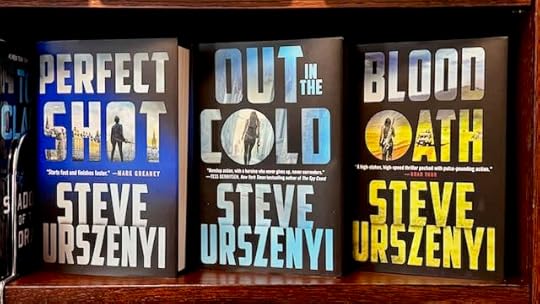
Here’s what’s different: unlike OUT IN THE COLD and PERFECT SHOT, which released with separate Canadian and International trade paperback editions, BLOOD OATH will launch simultaneously across North America in hardcover format only. There won’t be a separate Canadian paperback edition at launch.
I know some of you have come to expect the Canadian paperback option, and I wanted to give you a heads-up about this change in my publisher’s distribution strategy. I also recognize that hardcover pricing represents a higher investment than a trade paperback. This is the premium hardcopy edition—designed with quality binding, heavier paper, and that collectible feel that makes it perfect for your bookshelf. The good news? You’ll still get the book on the same day as U.S. readers, and it will be widely available through all major Canadian retailers.
For those who prefer other formats: the audiobook edition, once again brilliantly narrated by Cynthia Farrell, and the ebook version will also be released on November 18.
Where to get your copy:
Blood Oath will be available November 18 from:
Amazon Canada
Chapters/Indigo
Your favorite independent Canadian bookstore
You can pre-order now to secure your copy on release day.
What’s BLOOD OATH about?
In the heart of Africa, Alex Martel’s safari with her father spirals into a deadly game of betrayal when he’s kidnapped by rebel forces. As Russian mercenaries and Chinese operatives descend on East Africa hunting for military secrets locked in her father’s mind, Alex must embrace her darkest instincts to save him. It’s her most personal—and dangerous—mission yet.
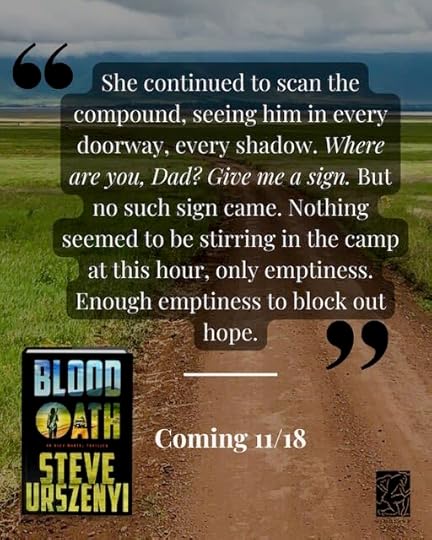
As New York Times bestselling author Tosca Lee said: “Steve Urszenyi delivers his most gripping thriller yet—an explosive mix of heart-pounding action, razor-sharp tradecraft, and the bonds that define heroism. Special Agent Alex Martel is fierce, unforgettable, and unstoppable.”
I appreciate your continued support of the Alex Martel series, and I’m excited for you to join Alex on this journey from the Serengeti to the highest levels of international intelligence. Thank you for being part of this adventure.
Until next time, stay safe out there.
Steve
P.S. If you’ve enjoyed the Alex Martel series, the greatest gift you can give is spreading the word. Share your thoughts on social media, leave a review, or tell a friend who loves thrillers. Word of mouth makes all the difference.
Blood Oath releases November 18, 2025. Preorder your copy today and discover how ancient honor codes drive the most modern of thrillers.

🇺🇸 Amazon US: Order on Amazon US
🇨🇦 Amazon Canada: Order on Amazon Canada
📖 Indigo Books: Order on Indigo Books
🏢 Barnes & Noble: Order on Barnes & Noble
📚 Novel Spot (Local Indie): Order at Novel Spot
💪 Why pre-order matters: Your pre-order helps boost the book’s visibility, supports independent bookstores, and ensures you get your copy on release day - November 18th!
👥 Help spread the word! Share this with fellow thriller fans who love heart-pounding Alex Martel adventures. Every pre-order makes a difference for authors like me!
🎯 Don’t wait - secure your hardcover copy now and be among the first to dive into Alex’s most dangerous mission yet!
#BloodOath #PreOrderNow #ThrillerBooks #AlexMartel
October 23, 2025
Into the Heart of Africa: Part 5
“Serengeti is Maasai for ‘endless plains,’” I wrote in my journal on Tuesday, June 11th. “The scenery was so stark and beautiful—as far as the eye could see, there was nothing but flat plains.”

Standing at the entrance to Serengeti National Park after leaving the Maasai village and Oldupai Gorge that morning, I felt something shift inside me. This wasn’t just another destination on our safari itinerary. This was the place where humanity first stood upright and looked out at the horizon. This was where Blood Oath would find its soul.
Where It All BeganOur stop at Olduvai Gorge earlier that day had been more than a tourist attraction—it was a pilgrimage to the birthplace of human consciousness. Here, in this 30-mile-long ravine carved through ancient volcanic layers, Louis and Mary Leakey made discoveries that changed our understanding of who we are.
In 1959, Mary Leakey found the fossilized skull of Zinjanthropus boisei (later reclassified as Paranthropus boisei), a 1.75-million-year-old hominid nicknamed “Nutcracker Man” for its massive molars. The following year, they discovered Homo habilis—“handy human”—believed to be the first toolmaker, dating back two million years.
The museum-like displays at Olduvai explained the history of Homo sapiens and the Leakeys’ revolutionary work. But what struck me most wasn’t the fossils themselves. It was standing in the place where our ancestors first became human, where they first made tools, first organized hunts, first developed the bonds of family and tribe that would define our species.
These ancient humans survived in the same landscape we were about to enter: the Serengeti, where predator and prey have engaged in their eternal dance for millions of years.
The Place Where Land Runs ForeverSerengeti—the word itself is poetry. In the Maasai language, it means “endless plains” or “the place where the land runs on forever.” Covering 5,700 square miles (14,750 square kilometers) of grassland plains, savanna, riverine forests, and woodlands, the Serengeti is one of the largest and oldest parks in Africa.
As we drove into the park and had our box lunch at the entrance, I began to understand what “endless” truly meant. The horizon stretched in every direction without interruption. No mountains to break the view. No forests to obscure the distance. Just grass and sky meeting somewhere beyond comprehension.
“The scenery was so stark and beautiful,” I noted. This wasn’t the lush abundance of Tarangire or the dramatic amphitheater of Ngorongoro. This was something primal—a landscape that hadn’t changed since those first humans stood upright and gazed across the same plains.
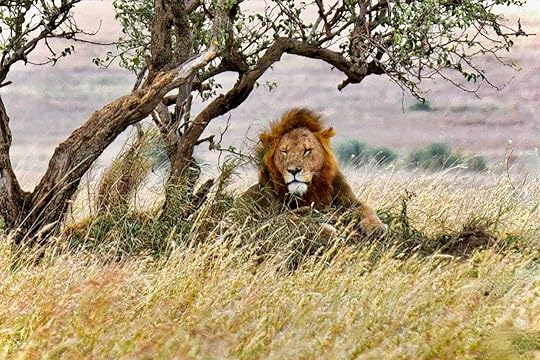
The scenery shifted as we drove—from sparse scrubland to longer grassland to trees and mountains that marked the Great Rift Valley, to kopjes that rose from the plains like rocky islands in a sea of grass. These ancient granite outcrops, some over 500 million years old, thrust upward through the volcanic soil, their weathered surfaces offering refuge to predators and prey alike. But always, that sense of vastness remained.
You could see forever, and forever looked back at you.
Lions on the HuntWithin an hour of entering the park, we came across a pride of lions hunting zebra. The encounter would later inspire one of the most intense sequences in Blood Oath.
Four lions worked in coordinated silence. The female led the stalk, keeping low as she crept toward outlying zebra, closing the distance foot by careful foot. She got to within 20-30 feet before exploding into a sprint, chasing her target for about 50 yards and closing to within 3-4 feet of its hindquarters before the zebra’s superior endurance won the race, the drama unfolding virtually beside our jeep.
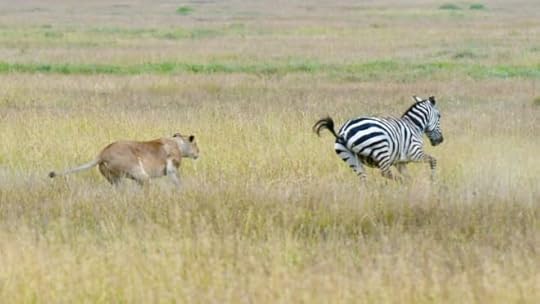
“Incredible to see,” I wrote, my hand probably still shaking from the adrenaline.
Watching that hunt unfold, I understood something crucial about predation: it’s not about strength or speed alone. It’s about patience, strategy, and accepting that most hunts fail. The lions would try again. And again. Until finally, hunger or opportunity aligned and they succeeded.
In Blood Oath, when Alex Martel pursues her father’s kidnappers across East Africa, she employs the same relentless patience. She fails multiple times. The kidnappers escape. Opportunities slip away. But like lions, she keeps hunting because survival demands it.
The Great MigrationWe saw giraffes, all types of antelopes, zebra, and wildebeest—big herds that were part of the Great Migration, that spectacular phenomenon where over 1.2 million wildebeest, 300,000 zebra, and thousands of other animals move in an endless cycle through the Serengeti-Mara ecosystem.
The migration follows ancient routes dictated by rainfall and the growth of new grass. The animals travel 800 to 1,000 kilometers in their annual circuit, facing predators at every turn: lions, leopards, cheetahs, hyenas, wild dogs, and crocodiles waiting at river crossings.
We had arrived at the tail end of this massive movement. James told us these were “the last part of the great migration” we were witnessing. But even the stragglers numbered in the thousands, their collective presence a reminder of how life persists through movement, adaptation, and the willingness to face danger for the promise of survival.
Hidden Predators and Ancient RocksWe saw elephants way off in the distance, hippos in a marshy pond, and the eye of a crocodile in the same water—motionless, patient, deadly. High atop one of the kopjes, we spotted a young leopard, so perfectly camouflaged against the ancient granite that even James had difficulty pointing her out. She had returned from a night hunt and was calling to her cubs, the low rumble inviting them to rendezvous among the cracks and caverns of the rock outcrop.

Watching her survey the plains from that elevated vantage point, I understood why these rock formations would become so significant in Blood Oath. In a landscape of endless flatness, the kopjes offer the only strategic high ground—perfect for observation, ambush, and refuge. In Blood Oath, they would become sites where hunters become the hunted, where desperate stands are made, where survival depends on understanding that in the Serengeti, elevation equals advantage.
We also saw the Topi, a large antelope we hadn’t encountered yet, along with waterbuck, warthogs, ostriches, dik-diks, impalas, and gazelles. The biodiversity was staggering—proof that “endless plains” doesn’t mean empty plains.
The Lodge at the End of the WorldWhen we arrived at the Serena Serengeti Lodge around 4 PM, I felt like I’d reached the edge of civilization. The lodge was beautiful—we stayed in round huts with thatched roofs that looked like Maasai houses. The main lodge featured a gorgeous infinity pool that seemed to spill directly into the savannah.
But beauty came with constant reminders of danger. “We need an escort once it’s dark to take us from our room to the main lodge due to danger from the wild animals. Current risk is a cape buffalo that comes at dusk to drink from the pool.”
This detail—needing escorts to walk between buildings after dark—would become integral to Blood Oath’s atmosphere. Even in places designed for human comfort and safety, the wild remains in control. The buffalo doesn’t recognize property lines or respect human schedules. It comes to drink when it’s thirsty, and humans must adjust or face consequences.
Dust and Distance“Today was a very windy and dry dusty day—we were caked in dust,” I noted. “Nice to have our evening shower and wash it all away.”
That dust coats everything—vehicles, clothes, skin, equipment. It gets in your eyes, your mouth, your lungs. It’s a constant reminder that the land is ancient and unforgiving, that humans are temporary visitors in a place that existed long before us, and will exist long after we’re gone.
The Vastness That Shapes the StoryOur routine had become familiar by this point: arrive at the lodge around 4-5 PM (all vehicles must be off the roads by dark at 6 PM—both for safety and to give the animals a break from human intrusion), head to the bar for drinks, shower and rest, dinner around 8 PM, more drinks, bed by 10:30-11 PM, then up at 5:45 AM for breakfast and back on the road by 7 AM.
This rhythm—dictated entirely by the sun and the requirements of wildlife viewing—would shape the pacing of Blood Oath. In the novel, time is measured differently. There’s no running to meetings or catching flights. There’s sunrise and sunset, and the hours between when—if you’re lucky—you can see what’s trying to kill you.
The Serengeti taught me about scale and proportion. In cities, we measure distance in minutes or miles. Here, you measure it in horizons. Something can be visible for hours before you reach it—or it reaches you.
This psychological effect of vastness became crucial to Alex’s emotional journey in Blood Oath. When her father is kidnapped and carried away into this endless landscape, the enormity of the search mirrors the enormity of her loss. How do you find one person in a place where the land runs on forever?
What’s ComingNext Thursday, we’ll dive into the spectacular wildlife encounters of our second day in the Serengeti: the orphaned lion cub clinging to survival, the cheetah family in the short grass, and our remarkable tracking of the magnificent Seronera Pride across multiple sightings throughout a single morning. We’ll also witness thousands of wildebeest suddenly breaking into their synchronized run, creating one of the most spectacular sights of our entire journey, and discover a leopard’s kill cached high in a tree—a grotesque monument to predator dominance that would hang there for months.
But the greatest lesson of this first day in the Serengeti was simpler: in a place this vast, you’re never really lost. You’re just somewhere in the endless plains, where humans first learned to stand upright and look toward the horizon.
In Blood Oath, Alexandra Martel will learn the same lesson—though the cost of that knowledge will be almost more than she can bear.
Asante sana for continuing this journey. The great hunt begins next week.
Steve Urszenyi
Blood Oath releases November 18, 2025. Preorder your copy today and discover how ancient honor codes drive the most modern of thrillers.

🇺🇸 Amazon US: Order on Amazon US
🇨🇦 Amazon Canada: Order on Amazon Canada
📖 Indigo Books: Order on Indigo Books
🏢 Barnes & Noble: Order on Barnes & Noble
📚 Novel Spot (Local Indie): Order at Novel Spot
💪 Why pre-order matters: Your pre-order helps boost the book’s visibility, supports independent bookstores, and ensures you get your copy on release day - November 18th!
👥 Help spread the word! Share this with fellow thriller fans who love heart-pounding Alex Martel adventures. Every pre-order makes a difference for authors like me!
🎯 Don’t wait - secure your hardcover copy now and be among the first to dive into Alex’s most dangerous mission yet!
#BloodOath #PreOrderNow #ThrillerBooks #AlexMartel
October 16, 2025
Into the Heart of Africa: Part 4

Some encounters change you forever. Meeting Sanka, the chief’s son, was one of those moments—a glimpse into an ancient world that would stay with me for years to come, opening my curiosity to his people’s struggles and shaping the role of the Maasai in Blood Oath.
It was Tuesday morning, June 11th, and we’d gotten to sleep in a little—not leaving the lodge until 8 AM. Our first stop was a Maasai village where we were greeted by a young man whose wisdom and dignity would stay with me for years to come, sparking my curiosity about his people’s struggles and shaping the role of the Maasai in Blood Oath.
The Chief’s SonSanka approached us with the confident stride of someone born to leadership. Son of the village chief, he wore the traditional red, green, and black shuka that marked him as Maasai, his bearing both proud and welcoming. As he taught us about his people’s way of life, I was struck by something that would later become central to Blood Oath: how true authority comes not from force, but from the respect earned through wisdom and sacrifice.
In the novel, when Alexandra Martel first encounters the Maasai warrior Lemarti, she recognizes this same quality—the kind of leadership that emerges from protecting something larger than yourself, even when that protection comes at terrible personal cost.
Warriors Who Jump Higher Than LionsThe men and women were dressed in colorful clothes adorned with intricate beadwork, and they sang as the men prepared to perform the traditional hunting dance. The harmony of their voices filled the air, creating an atmosphere that belonged more to legend than to the modern world. As the Maasai men formed a semicircle, their voices rising in ancient chants, they began the adumu—the jumping dance that has tested warrior strength for centuries.
The men were jumping to show they could jump higher than a lion, I wrote in my journal, to show what good warriors they were and to attract more wives.
This wasn’t just performance—this was proof of worthiness. In Maasai tradition, the warrior who jumps highest demonstrates the strength needed to leap over fences during cattle raids, the agility required to escape predators, the explosive power that might mean the difference between life and death on the savannah.
Then they invited me to join the jumping.
An Honor and a HumblingStanding in that circle of warriors, trying to match their leaps while my middle-aged, worn-out ex-paramedic joints protested every attempt, I experienced something profound. For those few minutes, I wasn’t a tourist or an observer—I was a participant in a ritual that connected these men to their ancestors, to their land, to their identity as protectors.
“He did a pretty good job,” my journal notes Sanka declared diplomatically. The truth was more humbling and more meaningful: I was being welcomed into something sacred, even as my pathetic attempts at jumping made clear how far I fell short of their standards.
Ancient Technologies, Eternal WisdomAfter the dancing, the men demonstrated how to start a fire using only sticks and donkey dung—a technique unchanged for millennia. Watching skilled hands coax flame from friction, I realized I was witnessing the accumulated wisdom of a people who had survived in one of Earth’s most challenging environments.

Sanka then led us into his home, a circular hut with an entry that curved around the exterior to keep out the wind. Inside, everything served multiple purposes: beds made from large sticks with cow hide stretched over top, a central fire pit for cooking and warmth, a square hole in the roof for smoke to escape and light to enter.
“The women build the homes,” Sanka explained as we ducked through the low doorway. “The men bring the large sticks which form the framework, then it is covered with cow dung and water to form a ‘clay’ cover—this is done by the women. This makes the house water- and windproof.”
Family Structures, Ancient and ComplexSanka’s family structure reflected Maasai traditions that stretch back centuries. He had two wives and four children—two boys and two girls. His father, the chief, had eight wives. In Maasai culture, polygamy isn’t just accepted—it’s practical. With cattle requiring constant attention and children needing care, multiple wives ensure the family’s survival and prosperity.
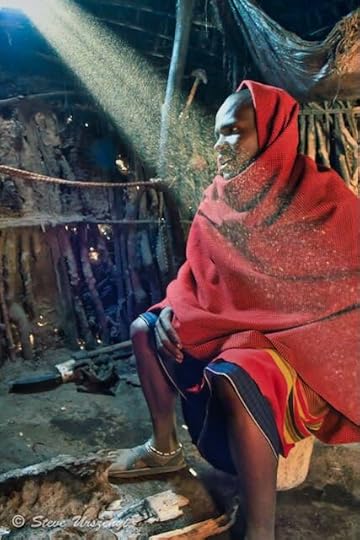
The village itself was a testament to this communal approach: about 120 people, all family members, tending about 150 cattle. In the center of the village, they had set up a small marketplace selling beadwork and traditional crafts.
It was here that the encounter turned personal—and where the seeds of Blood Oath’s themes took root.
The Talking Stick and the Price of ConnectionAmong the items we purchased was a talking stick made of ebony and beads. Sanka explained its significance: “When a mom or dad is holding the talking stick, a child must stop what they are doing and come over to hear what they have to say.”
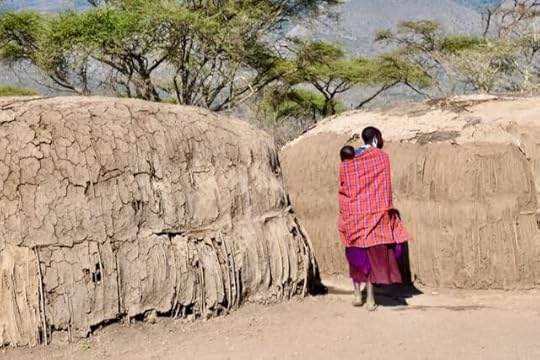
It was a physical symbol of parental authority, of the unbreakable bond between generations, of the responsibility that comes with being trusted with another’s well-being. In Blood Oath, the relationship between Alex and her father, General David Martel, embodies this same sacred responsibility—the obligation to protect those we love, regardless of the cost.
Education and the Price of ProgressAt the village school, we watched children demonstrate their English alphabet and numbers. They were taught both English and Kiswahili—preparation for a world beyond the village. Sanka explained their educational path: village school, then exams, then boarding school for elementary and high school, possibly university. But wherever they went, they frequently returned to support their families.
Some go on to university—wherever they go, they come back to the village to support their family with the money they can make, I noted in my journal.

This tension between tradition and modernity would become central to Blood Oath. How do you preserve what matters while adapting to survive? How do you honor your ancestors while preparing for a future they never could have imagined?
A Gift and a RecognitionAs we prepared to leave, Sanka gave us a gift—a carved giraffe, probably because we had purchased so much from the village marketplace. In return, we offered him a Cadbury chocolate bar for the children.
James, our guide, approved. “That was a very good thing to do,” he said.
This exchange—practical support disguised as gift-giving—captured something essential about the relationship between the Maasai and the modern world. The tribe had to buy water to fill large tanks, money that came from tourism, from selling their crafts, from the difficult navigation between maintaining their way of life and surviving in a cash economy.
The Diet of WarriorsJames shared a crucial detail about Maasai culture: “Their diet is strictly meat and milk from their cows—no vegetables or fruit (they’re not farmers).” Yet Sanka told us that because they lived close to the city, the government sold them corn, which they made into porridge.
Even their diet reflected the pressure between ancient ways and modern necessities. These were people adapting to survive while fighting to preserve their essential identity.
The Foundation of Blood OathOur encounter with Sanka and his family became the emotional and moral foundation of Blood Oath. The novel’s central conflict—between preserving what we value and adapting to survive—mirrors the challenges facing the Maasai today. The honor codes that drive Alex’s desperate mission to save her father echo the warrior traditions that still guide Maasai society.
Most importantly, that talking stick became a symbol that runs through the entire novel: the sacred responsibility we bear for those we love, the unbreakable bonds that define us, the prices we pay to honor those bonds.
When Alex faces impossible choices in the African wilderness, she’s guided by the same principles that have sustained the Maasai for centuries: courage, loyalty, and the understanding that some things are worth dying to protect.
What’s ComingNext Thursday, we’ll enter the legendary Serengeti—the “endless plains” where the great migration plays out against a backdrop of stunning beauty and constant danger. There, surrounded by the vastness that gives the Serengeti its name, I’ll experience the landscape where Alex’s most personal battle will unfold.
But first, I want to acknowledge what Sanka and his people taught me: that honor isn’t abstract—it’s a living choice we make every day. That family bonds transcend culture and geography. That the greatest warriors aren’t those who seek conflict, but those who protect what they love.
In Blood Oath, Alexandra Martel learns these lessons the hard way. But meeting Sanka showed me they were lessons worth learning.
Asante sana for walking this path with me. The endless plains await.
Steve Urszenyi
Thanks for reading Medic Turned Scribe! This post is public, so feel free to share it.
Blood Oath releases November 18, 2025. Preorder your copy today and discover how ancient honor codes drive the most modern of thrillers.

🇺🇸 Amazon US: Order on Amazon US
🇨🇦 Amazon Canada: Order on Amazon Canada
📖 Indigo Books: Order on Indigo Books
🏢 Barnes & Noble: Order on Barnes & Noble
📚 Novel Spot (Local Indie): Order at Novel Spot
💪 Why pre-order matters: Your pre-order helps boost the book’s visibility, supports independent bookstores, and ensures you get your copy on release day - November 18th!
👥 Help spread the word! Share this with fellow thriller fans who love heart-pounding Alex Martel adventures. Every pre-order makes a difference for authors like me!
🎯 Don’t wait - secure your hardcover copy now and be among the first to dive into Alex’s most dangerous mission yet!
#BloodOath #PreOrderNow #ThrillerBooks #AlexMartel
October 9, 2025
Into the Heart of Africa: Part 3
They call it the “Eighth Wonder of the World,” and standing on the rim of Ngorongoro Crater that foggy Monday morning, I finally understood why.
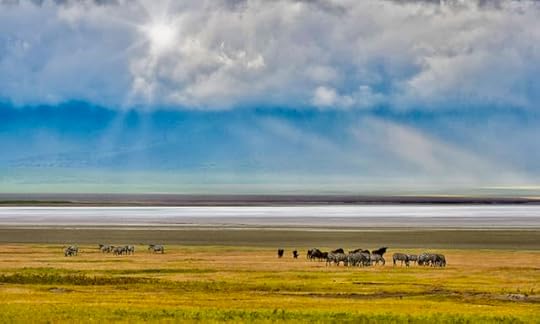
Twelve miles across and 2,000 feet deep, the crater yawned before us like the curvature of the Earth itself—a collapsed volcanic caldera that had been nature’s most spectacular accident some 2.5 million years ago. When that ancient volcano exploded and collapsed inward, it created what would become the world’s largest intact, unfilled volcanic crater. What we were looking down into wasn’t just a geological marvel—it was Africa’s Garden of Eden, a wildlife theater unlike anywhere else on Earth.
Descent into Eden“Light rain and very foggy at top of crater,” I wrote in my journal that morning. But James assured us it would be clear once we got down into the crater—he was right as usual.
James had become more than our guide; he was our translator for this ancient landscape, our David Attenborough with an infectious smile and encyclopedic knowledge. As we descended the winding road into the crater, the fog lifted like a theater curtain, revealing the stage where one of nature’s greatest dramas plays out daily.
At 8 AM sharp, we got our first glimpse of the crater’s most magnificent residents.
The Greatest Show on EarthA pride of lions lay in the grass—two females and two males, one older, one younger. At first, they simply lounged, occasionally lifting their heads with that bored royal indifference that only big cats can master. Then, as if someone had called “Action!” they all stood up and began walking directly toward our Land Cruiser.
What happened next would later inspire one of the most intense scenes in Blood Oath.
The lions came right onto the road in front of our jeep and walked along it for fifty feet before crossing into the grass beside us. One female lay down on the roadside, no more than five feet away. I could have reached out and touched her—though that would have been spectacularly stupid and dramatically final.

But the real show was just beginning.
Hunting Lessons from the MastersThe field the lions had crossed into was full of wildebeest, and we were about to witness what James called “better than David Attenborough”—a textbook lion hunt in real time, complete with our guide’s expert narration.
The two females began stalking the herd with surgical precision. One positioned herself visibly to the herd, staying in plain sight to distract them. Meanwhile, the second female circled behind, using the classic pincer movement that has made lions apex predators for millennia. As the visible female drew the wildebeest’s attention, they began moving away from her—directly toward the hidden huntress.
Then the two males joined the operation, stalking along the flanks to cut off escape routes.
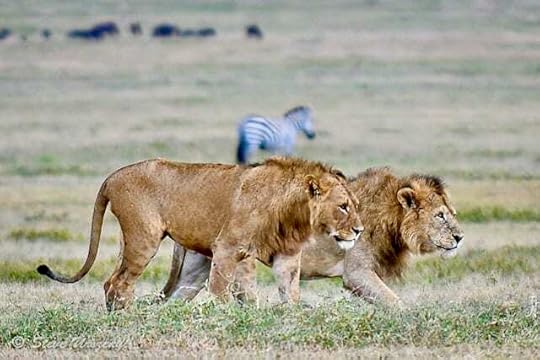
For thirty to forty minutes, we watched this coordinated tactical operation unfold. The lions demonstrated patience, intelligence, and teamwork that would impress any military strategist. In the end, they chose not to attack—perhaps the conditions weren’t perfect, or they simply weren’t hungry enough. But we had witnessed the blueprint of successful predation, and it was magnificent.
“We were so excited to see all of this,” I noted, “and it was only 8 AM!”
A Crater Full of WondersAs we continued our game drive, the crater revealed why it houses over 25,000 animals in just 100 square miles. Thousands of pink flamingos carpeted the edge of Lake Magadi like a living pink shoreline. We saw herd after herd of cape buffalo, wildebeest, zebra, and gazelle—all grazing together in the kind of abundance that existed across Africa before human interference.
The hippos provided comic relief and genuine surprise. We watched one galloping across the plain back to a small lake, moving at a speed we never imagined possible for such massive creatures. “We never realized hippos could move so fast,” I wrote, still amazed by the sight.
Most precious of all, we spotted four black rhinos—mere black dots through binoculars at about two kilometers distance, but incredibly significant. These are among only nineteen black rhinos remaining in the park, a critically endangered species clinging to survival in one of their last strongholds.
Nature’s Perfect TheaterWhat makes Ngorongoro unique isn’t just the wildlife density—it’s the setting. The crater walls rise 2,000 feet on all sides, creating a natural amphitheater where every drama of African wildlife plays out within perfect viewing distance. Unlike the endless plains of the Serengeti, where animals can disappear into vastness, the crater keeps its stars center stage.
In the afternoon, we encountered another lion pride lounging beside the road—four females and two males. One alpha female remained alert, carefully watching a mixed herd of wildebeest, cape buffalo, and zebra. James predicted they would attack that night, when darkness would give them the ultimate advantage.
The Inspiration Takes ShapeAs I absorbed these experiences, I began to understand what would drive Blood Oath’s most emotional scenes. The crater’s confined nature—beautiful but inescapable—would mirror Alex Martel’s psychological state when her father is kidnapped. Like the wildlife in the crater, she would be trapped in a contained environment where every move is visible, every decision carries life-or-death consequences.
The lions’ hunting techniques—patience, coordination, tactical thinking—would inform how Alex approaches her own desperate mission. The way the crater’s beauty masked constant predation would reflect how even paradise can turn deadly without warning.
Most importantly, the crater taught me about sanctuary. Here was a place where endangered species found refuge, where ancient rhythms continued despite the chaos of the outside world. In Blood Oath, Alex’s relationship with her father represents that same kind of sanctuary—a safe space that becomes worth dying to protect.
A Theater of LightBy afternoon, the crater had transformed completely. The morning rim, shrouded in clouds and fog, now blazed with sunshine. Rays broke through in cathedral shafts, illuminating the grasslands and creating what I called “beautiful visual effects” that made the whole landscape seem blessed.
We kept saying throughout that day: “How can it get any better than this!”
As it turned out, it couldn’t. But it could get more dangerous, more personal, and more emotionally complex—which is exactly what happens in Blood Oath when paradise becomes a battlefield.
What’s ComingNext Thursday, we’ll meet the Maasai—the encounter with Sanka and his family that opened my eyes to both ancient wisdom and modern injustice, shaping the cultural heart of Blood Oath’s story. We’ll witness traditional hunting dances, learn how to build a home from cow dung, and discover why some conflicts span generations.
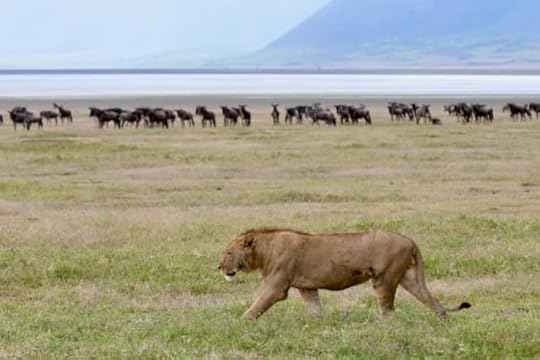
But first, let me leave you with the image that still gives me chills: those lions walking within touching distance of our vehicle, completely relaxed in their absolute power. In that moment, we were visitors in their kingdom, subject to rules we barely understood.
In Blood Oath, Alex Martel learns the same lesson in the most painful way possible.
Asante sana for continuing this journey. The kings await your visit to their crater.

Blood Oath releases November 18, 2025. Preorder your copy today and experience the thriller born from the world’s most magnificent wildlife theater.
🇺🇸 Amazon US: Order on Amazon US
🇨🇦 Amazon Canada: Order on Amazon Canada
📖 Indigo Books: Order on Indigo Books
🏢 Barnes & Noble: Order on Barnes & Noble
📚 Novel Spot (Local Indie): Order at Novel Spot
💪 Why pre-order matters: Your pre-order helps boost the book’s visibility, supports independent bookstores, and ensures you get your copy on release day - November 18th!
👥 Help spread the word! Share this with fellow thriller fans who love heart-pounding Alex Martel adventures. Every pre-order makes a difference for authors like me!
🎯 Don’t wait - secure your hardcover copy now and be among the first to dive into Alex’s most dangerous mission yet!
#BloodOath #PreOrderNow #ThrillerBooks #AlexMartel



